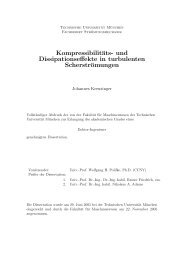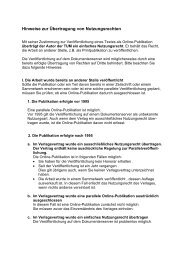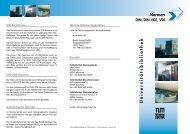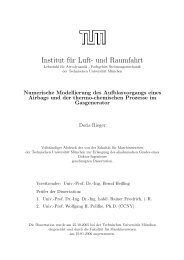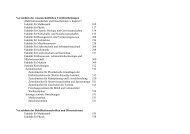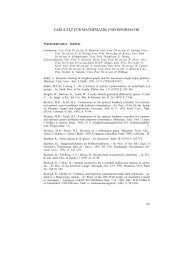LES of shock wave / turbulent boundary layer interaction
LES of shock wave / turbulent boundary layer interaction
LES of shock wave / turbulent boundary layer interaction
You also want an ePaper? Increase the reach of your titles
YUMPU automatically turns print PDFs into web optimized ePapers that Google loves.
33<br />
extended to the compressible case as:<br />
C finc = F C C f ,<br />
Re θinc = F θ Re θ .<br />
The van-Driest-II transformation for coefficients F C and F θ<br />
with<br />
F C =<br />
α =<br />
F θ = µ ∞<br />
µ w<br />
κ−1<br />
2 M 2 ∞r<br />
(arcsin α + arcsinβ) 2 ,<br />
2A 2 − B<br />
√<br />
4A2 + B 2 ,<br />
β =<br />
A =<br />
B =<br />
B<br />
√<br />
4A2 + B 2 ,<br />
√<br />
κ − 1<br />
(<br />
2<br />
M 2 ∞r T ∞<br />
T w<br />
,<br />
1 + κ − 1 M 2<br />
2<br />
∞r − T )<br />
w T∞<br />
T ∞ T w<br />
is found to be superior to others by Hopkins & Inouye (1971). Here<br />
r = 0.9 is the temperature recovery factor. Obviously, the considered<br />
case (Re δ2 ≈ 2000) is in the region <strong>of</strong> the rapid change <strong>of</strong> C f , where data<br />
are much more scattered than at higher Reynolds number (Re δ2 > 4000).<br />
The calculated skin friction coefficient lies close to the upper limit <strong>of</strong> this<br />
scatter, the referenced experiment at the lower, but both <strong>of</strong> them agree<br />
well with established data from Fernholz & Finley (1977, 1981) and<br />
empirical correlations.<br />
The wall normal distributions <strong>of</strong> mean Mach number, temperature,<br />
velocity, and density are compared with the experimental data in figure<br />
3.4. In the bulk, the computed velocity pr<strong>of</strong>iles agree well with the<br />
experimental data, minor discrepancies can be observed for the density<br />
and temperature pr<strong>of</strong>iles. These differences are well within the experimental<br />
error margin. The computed van-Driest-transformed velocity<br />
pr<strong>of</strong>iles, shown in figure 3.5, agree well with the logarithmic law <strong>of</strong> the<br />
wall U + VD = lnx+ 3 /0.4 + 5.1. Wall-law constants are taken for adiabatic<br />
walls, since our temperature at the wall is equal to the adiabatic one, this



